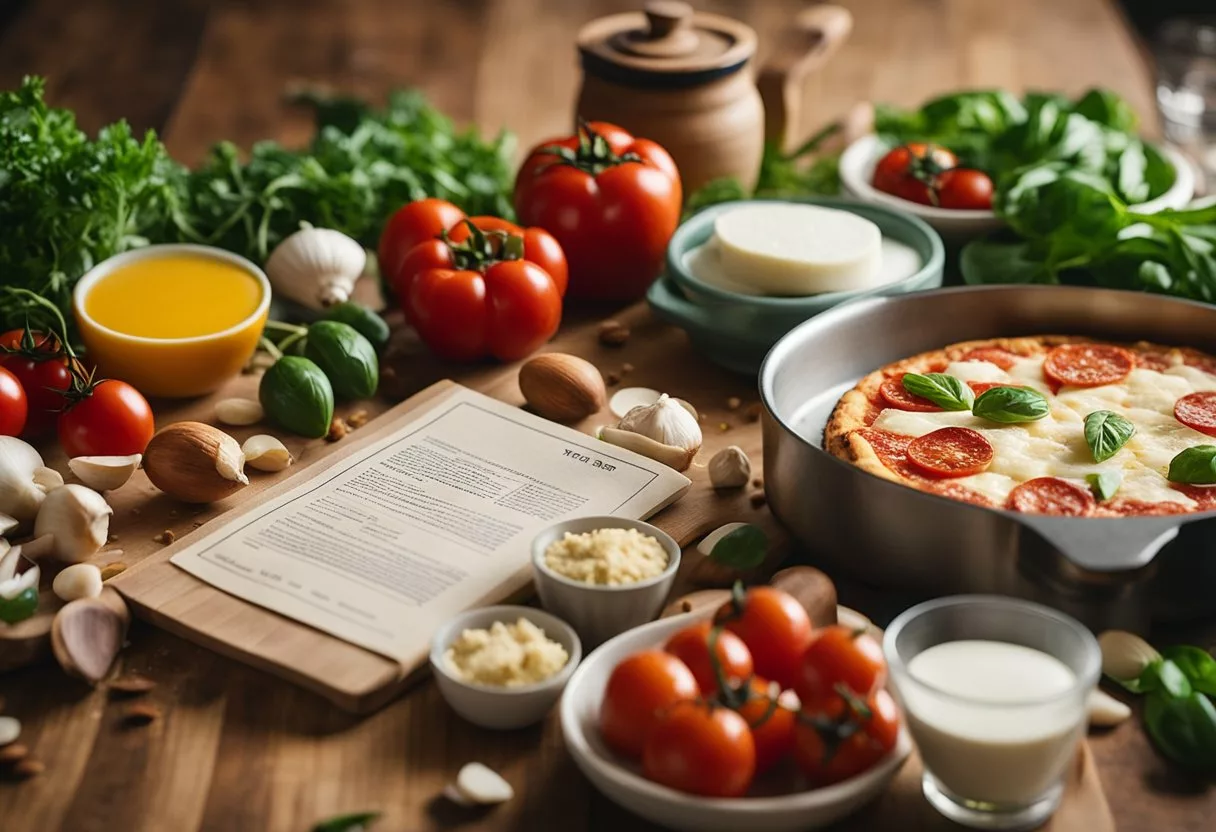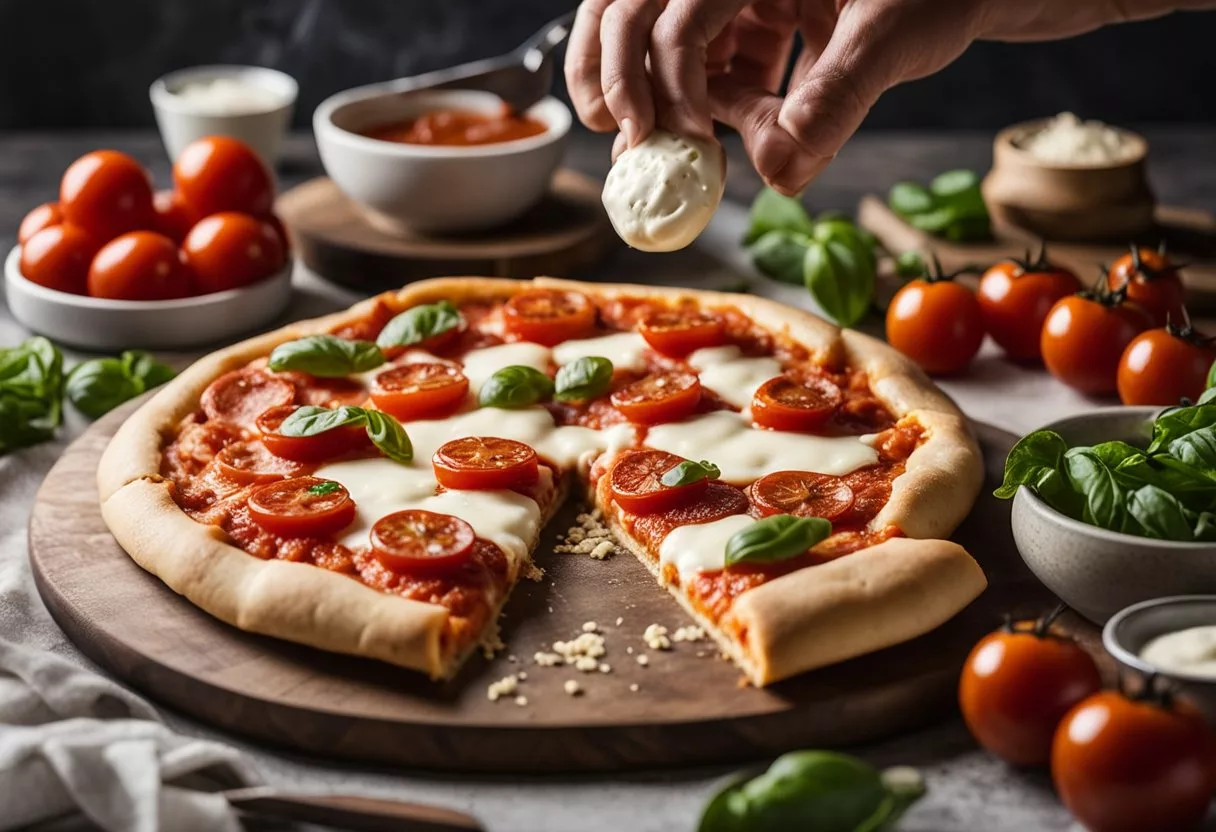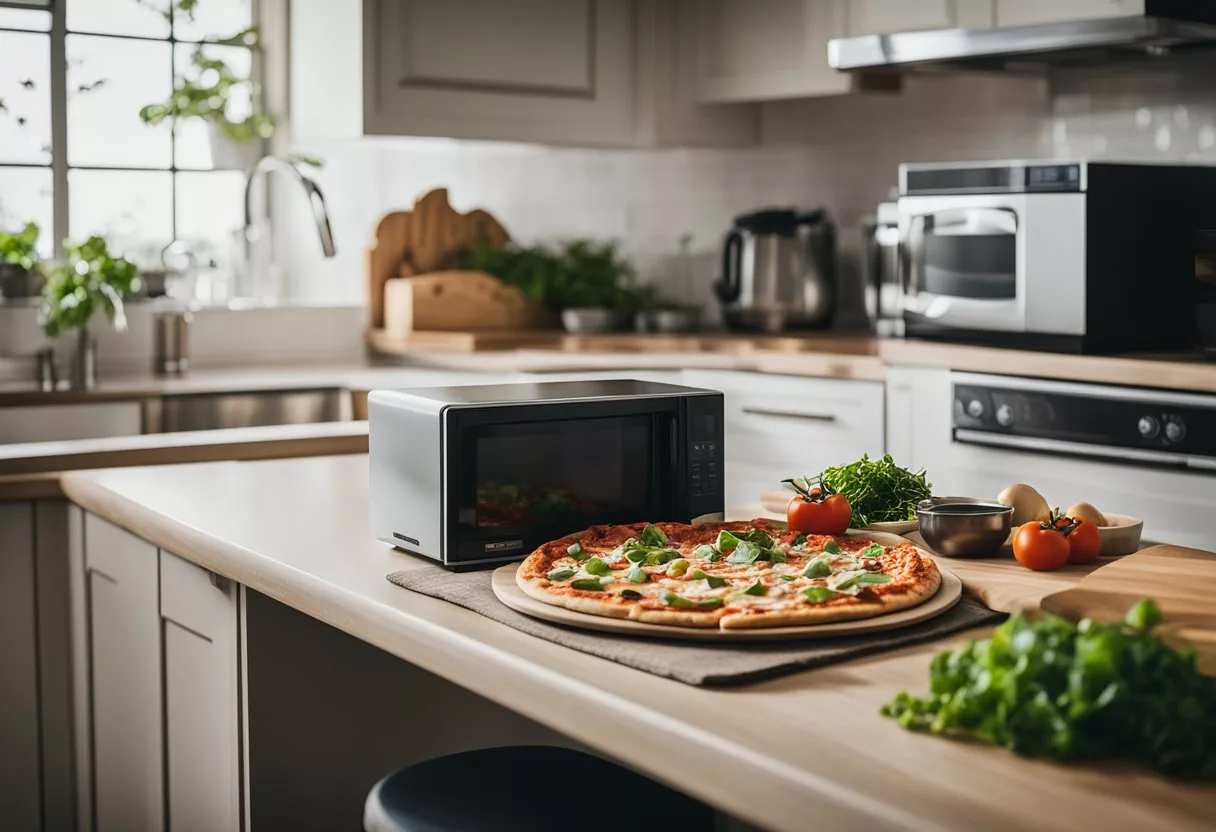Pizzas are a beloved dish around the world, synonymous with melted cheese, flavorful tomato sauce, and a plethora of toppings. However, for those following a ketogenic diet, traditional pizza, with its high-carb crust, poses a dietary challenge.
Fortunately, the culinary innovation of keto pizza recipes allows pizza enthusiasts to indulge in their favorite meal while maintaining a low-carb lifestyle. These recipes replace the traditional wheat-based crust with alternative ingredients like cheeses, ground almond or coconut flour, and even eggs to maintain the foundational flavors of pizza without the carbs.

The fusion of classic pizza flavors with keto-friendly ingredients results in a satisfying dish that one can enjoy without diverging from their dietary goals. Moreover, the versatility of keto pizza is apparent through the variety of crust bases and topping combinations offered.
From simple cheese and tomato pizzas to gourmet creations topped with diverse meats and vegetables, keto pizza can be as uncomplicated or as exotic as the maker desires. This adaptability extends to different dietary needs, making it possible to customize keto pizzas to be vegetarian, dairy-free, or even nut-free, widening its appeal to a broad audience.
Key Takeaways
- Keto pizza provides a low-carb alternative to traditional pizza, aligning with the ketogenic lifestyle.
- Recipes feature creative crusts made from low-carb flours and cheeses, sustaining the texture and taste of conventional pizzas.
- With a range of customizable options, keto pizzas cater to varying preferences and dietary restrictions.
Understanding the Keto Diet

The ketogenic or ‘keto’ diet revolves around the principle of minimizing carbohydrate intake while increasing consumption of healthy fats, which puts the body into a state of ketosis.
What is Keto?
The keto diet emphasizes a reduction in net carbs—the total carbohydrates minus fiber—to typically less than 50 grams per day. This carb restriction compels the body to switch its primary energy source from glucose to ketones, produced from the breakdown of fats. By doing so, the diet aligns macronutrient intake around high fat, moderate protein, and very low carbohydrates.
Benefits of a Keto Diet
Individuals adhering to a keto diet often experience weight loss as a result of the body’s increased fat-burning state known as ketosis. Some research suggests benefits such as improved blood sugar control and a possible reduction in risk factors for certain chronic diseases. The diet’s macronutrient distribution is typically around 70-80% fat, 20-25% protein, and 5-10% carbohydrates.
Fundamentals of Keto Pizza

Creating the perfect keto pizza revolves around substituting traditional high-carb elements with low-carb alternatives, ensuring a delicious result that complies with a ketogenic dietary regime.
Low-Carb Ingredients
The cornerstone of any keto pizza recipe is its selection of low-carb ingredients that replace conventional high-carb toppings and crusts. To maintain a ketogenic balance, one must choose toppings wisely, prioritizing those with minimal carbohydrate content. A classic keto pizza typically includes:
- Meats: Pepperoni, sausage, bacon, chicken
- Cheeses: Mozzarella, cheddar, parmesan
- Vegetables: Bell peppers, olives, spinach, mushrooms
- Sauces: Sugar-free tomato sauce, pesto, alfredo
In addition to topping selections, the choice of flour used in the crust is critical in keeping the carb count within keto-friendly parameters.
Keto Pizza Crust Options
A keto pizza crust aims to deliver the satisfying crunch and base for toppings without the excessive carbs found in traditional dough. Two popular flour options stand out:
- Almond Flour Crust: Rich in nutrients and naturally low in carbs, almond flour provides a sturdy and flavorful base for a keto pizza.
| Ingredient | Measurement |
|---|---|
| Almond Flour | 1.5 cups |
| Eggs | 2 (as a binder) |
| Mozzarella Cheese | 1.5 cups (shredded) |
- Coconut Flour Crust: An alternative for those with nut allergies, coconut flour is highly absorbent, requiring additional liquids or eggs to reach the desired consistency.
| Ingredient | Measurement |
|---|---|
| Coconut Flour | ¼ cup |
| Eggs | 2 (as a binder) |
| Cream Cheese | 2 oz. |
| Shredded Mozzarella | 1 cup |
Regardless of the choice between almond and coconut flour, both options frequently include eggs to help bind the mixture and create a dough-like texture. Additionally, incorporating cheese directly into the crust, such as a cheese crust pizza, can enhance flavor while adding structural integrity to the base.
Keto Pizza Recipes

Keto pizza recipes offer a delicious way to enjoy classic flavors without compromising a low-carb lifestyle. They typically swap traditional wheat crusts for alternatives made with cheese and almond or coconut flour, ensuring each slice keeps carbs in check while still satisfying that pizza craving.
Classic Keto Pepperoni Pizza
A Classic Keto Pepperoni Pizza is the go-to choice for anyone starting their keto journey. The crust for this pizza is often made with a “fathead” dough, consisting of:
- Almond flour
- Cream cheese
- Mozzarella cheese
After baking the crust to achieve a golden-brown edge, one spreads a thin layer of low-carb marinara sauce followed by a generous sprinkling of mozzarella. Pepperoni slices are then arrayed on top, and the pizza is baked until the cheese is perfectly melted.
BBQ Chicken Keto Pizza
The BBQ Chicken Keto Pizza is a flavorful twist on traditional pizza. It incorporates:
- A cheese-based crust
- BBQ sauce with reduced sugar
- Shredded chicken as the main protein
To prepare, one covers the prebaked crust with a layer of the keto-friendly BBQ sauce. Cheese, usually a mix of mozzarella and cheddar, is added over the sauce before topping with the shredded chicken. Additional toppings might include sliced red onions and a sprinkle of cilantro for fresh brightness.
Vegetarian Keto Pizza Varieties
Those preferring a meat-free option can delight in Vegetarian Keto Pizza Varieties. The crust is similar to the other keto versions, and from there, the possibilities for toppings are extensive. Popular vegetable toppings include:
- Spinach
- Mushrooms
- Bell peppers
- Onions
The key is to use a low-carb base, such as unsweetened marinara sauce or even an olive oil and garlic blend. Cheeses like mozzarella, feta, or goat cheese are sprinkled on top of the veggies for a satisfying finish.
Nutritional Information

When exploring keto pizza recipes, understanding the nutritional content is crucial for maintaining a low-carb diet. This section delves into the specifics of carb and calorie count, as well as the macronutrient profile that is essential for anyone following a ketogenic lifestyle.
Counting Carbs and Calories
Keto diets heavily focus on low carbohydrate intake, with an emphasis on net carbs, which are total carbs minus fiber. Most keto pizza crusts are designed to minimize carbs, usually resulting in net carbs that can range from 2 to 6 grams per serving. Calories in keto pizzas vary, often depending on the toppings and the type of cheese used. For example, a single serving can have approximately 348 calories, but this number can adjust based on the specific recipe and serving size.
- Net Carbs: Approximately 2-6g per serving, depending on the crust and toppings.
- Calories: About 249-348 per serving, influenced by ingredients and portion.
Macronutrients in Keto Pizza
The macronutrient distribution in keto pizza is configured to align with a high-fat, moderate-protein, low-carb framework. Keto pizzas often feature a significant amount of fat, which is a primary energy source on a ketogenic diet. Saturated fat content can be high, such as 11.423g per serving, which can contribute to 57% of the recommended daily value. For individuals monitoring cholesterol, a single pizza serving may offer around 105mg. It’s also prudent to consider sodium levels, especially for those with sodium sensitivities, as one slice can contain up to 680mg of sodium. Keto pizzas may not be high in vitamins and calcium unless these nutrients are present in the toppings chosen.
- Total Fat: Approximately 27.52g per serving, with 11.423g as saturated fat.
- Cholesterol: Around 105mg per serving.
- Sodium: Can be as high as 680mg per slice.
Cooking Tips and Techniques

When crafting keto pizza, the dough’s composition and the baking approach are pivotal for achieving that desirable, tasty crust. Precision in preparation and cooking can make all the difference.
Making the Perfect Keto Pizza Dough
For keto pizza dough, ingredients matter. Begin with a microwave-safe bowl, combining shredded mozzarella and cream cheese. Heating these in short bursts allows for easy blending. Baking powder is crucial for leavening, giving the dough a rise without traditional flour. Mix dry ingredients separately to ensure even distribution before combining with the cheeses.
For the dough handling, use parchment paper. This simplifies the process, prevents sticking, and makes transfer to the cooking surface seamless. When rolling or pressing the dough, aim for uniform thickness to ensure even cooking.
Baking and Cooking Methods
The oven must be preheated to achieve a crisp crust. Using a pizza stone or a heavy-duty pizza pan helps in distributing heat evenly, replicating a professional pizza oven’s results. If unavailable, a preheated skillet can serve as an alternative, providing a well-cooked base if the pizza is finished under a grill to melt the toppings.
For best texture, pre-bake the crust before adding toppings. This pre-bake can be around 10 minutes, but watch for a golden hue as an indicator. Once topped, return the pizza to the oven and cook until the cheese bubbles and the edges are crisp. This dual-stage baking technique ensures no sogginess, only satisfying crunchiness that characterizes a quality keto pizza.
Specialty Keto Pizzas

For those following a ketogenic diet, specialty keto pizzas offer a luxurious twist on traditional pizzas by incorporating unique, low-carb ingredients. These recipes are designed to satisfy cravings for meat-heavy or seafood-topped pizzas, without the typical carb-heavy crusts.
Meat Lovers’ Selection
Meat Lovers’ Keto Pizza: This pizza caters to those who enjoy a hearty dose of protein with their meal. It replaces the standard flour crust with more inventive bases like chicken crust or a crust made from almond or coconut flour.
- Toppings: Generously loaded with meats such as:
- Bacon: Crisped to perfection and scattered on top.
- Sausage: Seasoned and crumbled, providing a spicy bite.
- Ground Beef: Cooked and seasoned, offering a rich and satisfying taste.
- Canadian Bacon: A leaner option that brings a mild, smoky flavor to the pizza.
The meats are carefully selected for their flavor profiles and compatibility with other keto-friendly toppings, such as low-carb vegetables and a variety of cheeses.
Seafood Delights
Seafood Keto Pizza: Sea-lovers can rejoice with this pizza, which is equally delicious and aligned with keto dietary requirements. Bases for these pizzas are often made from cheese or cauliflower to complement the lighter seafood flavors.
- Toppings may include:
- Shrimp: Tender and seasoned, it provides a delicate taste.
- Scallops: When available, scallops add a gourmet touch.
- Crab Meat: Offers a sweet and succulent flavor.
The seafood is chosen not only for its taste but also for its nutritional profile, which is high in protein and omega-3 fatty acids, while remaining low in carbs.
Customizing Your Keto Pizza

Tailoring a keto pizza to personal tastes and dietary requirements involves choosing suitable low-carb ingredients and substitutes that maintain the flavor without compromising the diet.
Creative Topping Combinations
One can experiment with various toppings to create a keto pizza that’s both satisfying and unique. Consider the following combinations for a diverse flavor profile:
- Classic Margherita: Top with sliced mozzarella, fresh basil, and a keto-friendly tomato sauce.
- Mediterranean Delight: Use a mix of feta cheese, spinach, and red onion for a tangy, savory taste.
- Forest Mushroom: Combine mozzarella and an assortment of mushrooms for an earthy flavor.
- Bacon and Blue: Sprinkle blue cheese and crisp bacon bits for a bold and rich topping.
Dairy-Free and Egg-Free Alternatives
For those with dairy or egg sensitivities, keto pizza can still be a delectable option with the right substitutions:
- Dairy-Free Cheese: Replace traditional cheese with dairy-free alternatives. One can opt for cashew cheese or other nut-based cheese options.
- Egg-Free Binders: In place of eggs in the crust, consider using flax meal or chia seeds mixed with water to achieve a similar binding effect.
By selecting the appropriate ingredients, a keto pizza can cater to a wide range of dietary preferences while still being delicious and compliant with a ketogenic lifestyle.
Storing and Reheating

Proper storage and reheating methods are crucial to maintaining the quality and safety of keto pizza. These practices ensure that the pizza remains tasty and doesn’t spoil.
Refrigeration and Freezing
Refrigeration: Keto pizza can be safely stored in the refrigerator for up to five days. One should place the leftover pizza in an airtight container or wrap it tightly with aluminum foil or plastic wrap.
Freezing: For longer storage, keto pizza can be frozen for up to six months. It’s essential to use an airtight container or freezer-safe bags to prevent freezer burn and preserve flavor. Always allow the pizza to cool down to room temperature before placing it into the freezer to maintain texture integrity.
Best Practices for Reheating
To ensure that the keto pizza retains its taste and texture when reheating:
- Microwave: If in a hurry, one can microwave the pizza for 30-40 seconds. It’s recommended to cover the pizza with a damp paper towel to keep the moisture in and avoid drying it out.
- Oven: For a more even reheating and crispier crust, warming up the pizza in a preheated oven is preferred. Heat at a moderate temperature, usually around 350 degrees Fahrenheit, until the pizza is heated through. This might take between 5 to 10 minutes depending on the pizza size and thickness.
Variations of Keto Pizza

Keto pizza lovers have a rich palette of crust options tailored to low-carb diets. Each base brings a unique texture and flavor, allowing for personalization and dietary compliance.
Cauliflower Crust Pizzas
Cauliflower crust serves as a staple in the keto community due to its low carb content and vegetable-based composition. The crust typically combines riced cauliflower with cheese and egg to bind it, providing a crisp edge once baked. Cauliflower crust pizzas are an excellent source of nutrients and cater to those seeking a grain-free alternative.
Chicken Crust Pizzas
For those who prioritize protein intake, chicken crust pizzas offer a novel approach. The crust is made primarily from ground chicken, creating a sturdy, protein-rich base. It’s an innovative spin that not only cuts down on the carbs but also amps up the protein, servicing the fitness-conscious keto adherents.
Alternative Keto Pizza Bases
The journey for the perfect keto pizza base doesn’t end with cauliflower and chicken. Alternative bases include:
- Zucchini Pizza Crust: Zucchini crust presents a moisture-rich and fiber-filled option, often requiring additional ingredients for firmness.
- Fathead Pizza Crust: A fan-favorite, fathead crust employs a dough made from almond flour, cream cheese, and mozzarella, delivering a chewy, bread-like texture without the carbs.
- Low Carb Pizza Crust: This encompasses a variety of recipes, some using coconut flour or other nut flours to achieve a palatable base that supports a range of toppings without breaking the ketosis state.
Beyond Pizza: Keto Pizza-Inspired Dishes

When one thinks of keto pizza options, the imagination need not be limited to just traditional pizza formats. These pizza-inspired keto dishes incorporate the robust flavors of pizza in forms that may offer more convenience or variety to those following a keto diet.
Keto Pizza Casserole
Keto Pizza Casserole takes the beloved elements of pizza and translates them into a hearty, bake-and-serve dish. It typically eliminates the need for a crust by layering toppings like pepperoni, melted mozzarella, and a keto-friendly tomato sauce over a base of seasoned ground meat. Some versions may include a blend of cheeses including ricotta or Parmesan to create a crust-like texture on top.
Food List for Keto Pizza Casserole:
- Ground beef or sausage
- Mozzarella cheese
- Ricotta or Parmesan cheese (optional)
- Low-carb tomato sauce
- Pepperoni slices
- Bell peppers, onions, mushrooms (optional)
- Italian seasoning
Deconstructed Pizza and Skillet Dishes
For individuals who enjoy the simplicity of skillet meals, deconstructed pizza and skillet dishes are an excellent keto option. These meals sidestep the traditional crust entirely, focusing instead on a rich mix of toppings cooked together. A popular variant in this category is the crustless pizza, which is essentially a skillet-cooked medley of pizza toppings that are usually served wrapped in low-carb tortilla wraps to mimic the handheld nature of a pizza slice.
Key Components for Deconstructed Pizza and Skillet Dishes:
- Crustless pizza ingredients stir-fried in a skillet
- Mozzarella and provolone cheese for melting
- A variety of meats such as pepperoni, bacon, or Italian sausage
- Keto-friendly vegetables like spinach or zucchini
- Wrap in a low-carb tortilla for convenient serving
Frequently Asked Questions

In this section, one will find succinct answers to common inquiries regarding the preparation and sourcing of keto-friendly pizza options.
How do you prepare keto pizza dough using yeast?
Keto pizza dough utilizing yeast typically involves a blend of low-carb flours like almond or coconut flour, combined with psyllium husk powder to mimic the texture of traditional dough. Yeast is added for its rise and flavor, with sugar sometimes included to activate it, though the sugar is consumed during fermentation and doesn’t impact the carb count significantly.
Where can I find keto-friendly pizza options nearby?
One can locate nearby keto pizza options by searching for restaurants that offer low-carb menus. Additionally, many establishments are now aware of dietary preferences and may provide keto-based creations upon request. Online delivery platforms may also filter for restaurants offering such alternatives.
What are the alternatives for traditional pizza crust on a keto diet?
Alternatives for traditional pizza crust on a keto diet encompass a variety of bases such as cauliflower crust, chicken breast crust, egg and cheese-based crusts like Fathead dough, and vegetable-based options like zucchini. These alternatives aim to lower the carbohydrate content while providing a pizza-like experience.
What ingredients are used in a chicken-based keto pizza crust?
A chicken-based keto pizza crust is commonly made with ground chicken as the primary component for the base, often combined with cheese, seasonings, and may include a binding agent like egg to hold the crust together while cooking.
What options are available for keto-friendly pizzas at chain restaurants?
Chain restaurants may offer keto-friendly pizzas by providing crusts made from low-carbohydrate ingredients like almond flour or cauliflower. One can inquire about custom toppings to ensure the overall carb count remains within keto diet limits.
How can you make a keto pizza casserole at home?
To make a keto pizza casserole at home, one layers ingredients such as cooked ground meat, low-carb pizza sauce, a mix of cheeses, and keto-friendly vegetables in a baking dish. This dish is then baked until the cheese is bubbly and golden, offering a comforting, pizza-flavored meal without the traditional crust.
